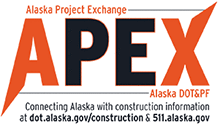St. Mary’s Airport Improvements
Project Number: Z605630000

Figure 1: Project area for the St. Mary’s Airport Improvements project.
Current Status
The Alaska Department of Transportation and Public Facilities (DOT&PF) in cooperation with the Federal Aviation Administration (FAA) is proposing to upgrade existing aviation facilities under the Saint Mary’s Airport Improvements project . The purpose of the proposed project is to improve safety at Saint Mary’s Airport by upgrading existing aviation facilities to meet current FAA standards for the De Havilland Canada Dash 8-100 and Cessna 208 Caravan, the design aircraft for Runway 17/35 and Runway 6/24, respectively. Saint Mary’s and the surrounding communities served by the airport are not connected to the Alaska State Highway System. Freight is barged to Saint Mary’s in the summer months or flown into the airport year-round. The continued safe operation of Saint Mary’s Airport is critical; the airport is a hub for residents, visitors, bypass mail, freight, medical emergencies/needs, and commercial fishing shipping.
The primary north/south runway (17/35) does not currently meet the FAA 600-foot runway safety area (RSA) standard beyond each runway end and the runway surface has degraded over time. The cross-wind runway (6/24) does not currently meet the FAA standard safety area width of 150 feet and the runway surface has degraded over time. All runway and taxiway lighting components and most navigational aids are more than 24 years old and at the end of their useful life. There are existing embankment drainage issues in many locations and water is present in the surface and subsurface of many runway, taxiway, and apron areas. Drainage ditches around the airport facilities would need to be shifted based on the proposed changes in airport layout Taxiway A and B and the transient and main aprons also have degraded surfaces.
Work on this project includes:
- Resurfacing the runway and taxiway surfaces
- Replacing the airport lighting and navigational aids
- Drainage improvements
Project Schedule
| Draft EA | October 18, 2021 |
| Public Meeting | November 22, 2021 |
| Draft EA Comments Due | November 24, 2021 |
| Final EA and FONSI | January 2022 |
| Construction | Summer 2022-2024 |
Environmental Assessment
Because improvements to Saint Mary’s Airport would require FAA Alaskan Airports Division approval and federal funding (a federal nexus as defined under the National Environmental Policy Act), an Environmental Assessment was prepared to evaluate the environmental effects of the proposed project. This document evaluates an action and no-action alternative relative to the social, economic, and environmental effects.
The environmental assessment and finding of no significant impacts are available to the public.
Current Documents
- Notice of Public Hearing Availability
- Complete Draft Environmental Assessment w/ Appendices 100mb
- Draft Environmental Assessment (Report Only) 4mb
- Appendices
- Appendix A: Figures 20mb
- Appendix B: Draft Engineer’s Design report
- Appendix C: USFWS – Information for Planning and Consultation Results 4mb
- Appendix D: Essential Fish Habitat Assessment
- Appendix E: 2021 Wetland Delineation Report 250mb
- Appendix F: Summary of Consultation and Coordination 59mb
- Finding of No Significant Impact
Project History
DOT&PF, in cooperation with the FAA, completed a Draft Runway Safety Area (RSA) Practicability Study in 2018 to identify RSA improvement alternatives for Runway 17-35. DOT&PF used the results of this study as the basis for the current proposed action for improvements. Three preliminary RSA improvement alternatives were evaluated in the study:
- Displace Runway 17-35 Thresholds (using Declared Distances) to shorten available runway landing length but maximize take-off length.
- Extend existing Runway 17-35 embankment 822 feet to the north and shift existing runway thresholds north to provide standard 600-foot RSA length beyond each runway end.
- A combination of extending Runway 17-35 embankment to the north, relocating thresholds, and using declared distances.
Additional alternatives such as installing an engineered materials arrestor system (EMAS), constructing of standard RSAs beyond the existing thresholds, and others were also considered in the RSA Practicability Study. Each alternative was analyzed for engineering practicability and financial feasibility.
Past Documents
- Figures 1-5
- Preliminary Environmental Overview
- Project Status Update February 2018
- Project Area
- Public Involvement Plan
- Scoping Summary Report 36mb
- Preliminary Environmental Overview
- Aviation Activity Forecast 12mb
- Conditions and Needs Assessment 3mb
Previous Public Involvement
Public Meeting (Environmental Scoping meeting), June 3, 2021 virtual online meeting.
- See Appendix F: Summary of Consultation and Coordination for meeting documents.
Public Meeting, March 26, 2019, 4:00 to 7:00 p.m. at St. Mary’s City Hall
Public Meeting April 2018
Project Information

Use DOT&PF’s Alaska Project Exchange tools to learn more about all of DOT&PF’s active construction projects statewide!
Want to know how construction will impact road traffic? Visit 511.alaska.gov
Want to dig into the details about projects across the state? Visit dot.alaska.gov/construction
For more information, contact:
Christopher Johnston, P.E.
Engineering Manager
![]() chris.johnston@alaska.gov
chris.johnston@alaska.gov
![]() (907) 451-2322
(907) 451-2322
Alaska Department of Transportation & Public Facilities
2301 Peger Road
Fairbanks, AK 99709
For individuals requiring TTY communications, please contact Alaska Relay at 7-1-1 or 1-800-770-8973.
PLEASE NOTE: Adobe Acrobat PDF files require a free viewer available directly from Adobe.
